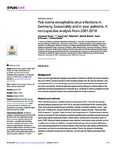Tick-borne encephalitis virus infections in Germany. Seasonality and in-year patterns. A retrospective analysis from 2001-2018
Borde, Johannes P.
Kaier, Klaus
Hehn, Philip
Böhmer, Merle M.
Kreusch, Teresa M.
Dobler, Gerhard
Background
Little is known regarding the changing seasonality of infections with the tick-borne encephalitis virus (TBEV) and the incidence of the resulting disease over the last two decades. Seasonal patterns have to our knowledge not previously been systematically investigated and are poorly understood. We investigate emerging seasonal changes in clinical aspects like potentially increasing hospitalization during the year, variations in clinical symptoms and disease severity during the season and seasonal dynamics of fatal outcomes.
Material and methods
TBEV infection became a notifiable disease in Germany in 2001. We used the national reporting dataset spanning from 2001–2018, provided by the Robert Koch-Institute (RKI). There were general epidemiological variables available, including “symptom onset”, “age” and “sex”. Furthermore, several variables documented disease severity. These included “CNS symptoms”, “myelitis”, “fatal outcome” and “hospitalization”. Potential factors influencing the occurrence of CNS symptoms, myelitis, hospitalizations and fatal outcome were analyzed using logistic regression models. Linear trends, including the “time point in year” at which TBEV infection related symptoms were detected, were tested using calendar year as a continuous covariate. In addition, seasonal trends and age and sex specific differences were exploratively tested for non-linear effects using restricted cubic splines with knot locations based on Harrell's recommended percentiles. Finally, the dynamic relationship between in-seasonal trends year of detection, sex and age was tested using interaction terms.
Results
6,073 TBEV infection cases from 2001–2018 were included in our analysis. We find that from 2001–2018 TBEV infections are reported 0.69 days earlier each year (p<0.001). There was no detectable seasonal variation regarding the occurrence of fatal outcome, CNS and myelitis. However, there was a significant changing trend regarding hospitalizations over the course of the year: The risk for hospitalization increases until August, decreases again from October on.
Conclusion
We present epidemiological evidence that the TBE season in Germany has shifted to start earlier over the last years, beginning approximately 12 days earlier in 2018 than it did in 2001. There are seasonal patterns regarding a higher risk of hospitalization during August.

